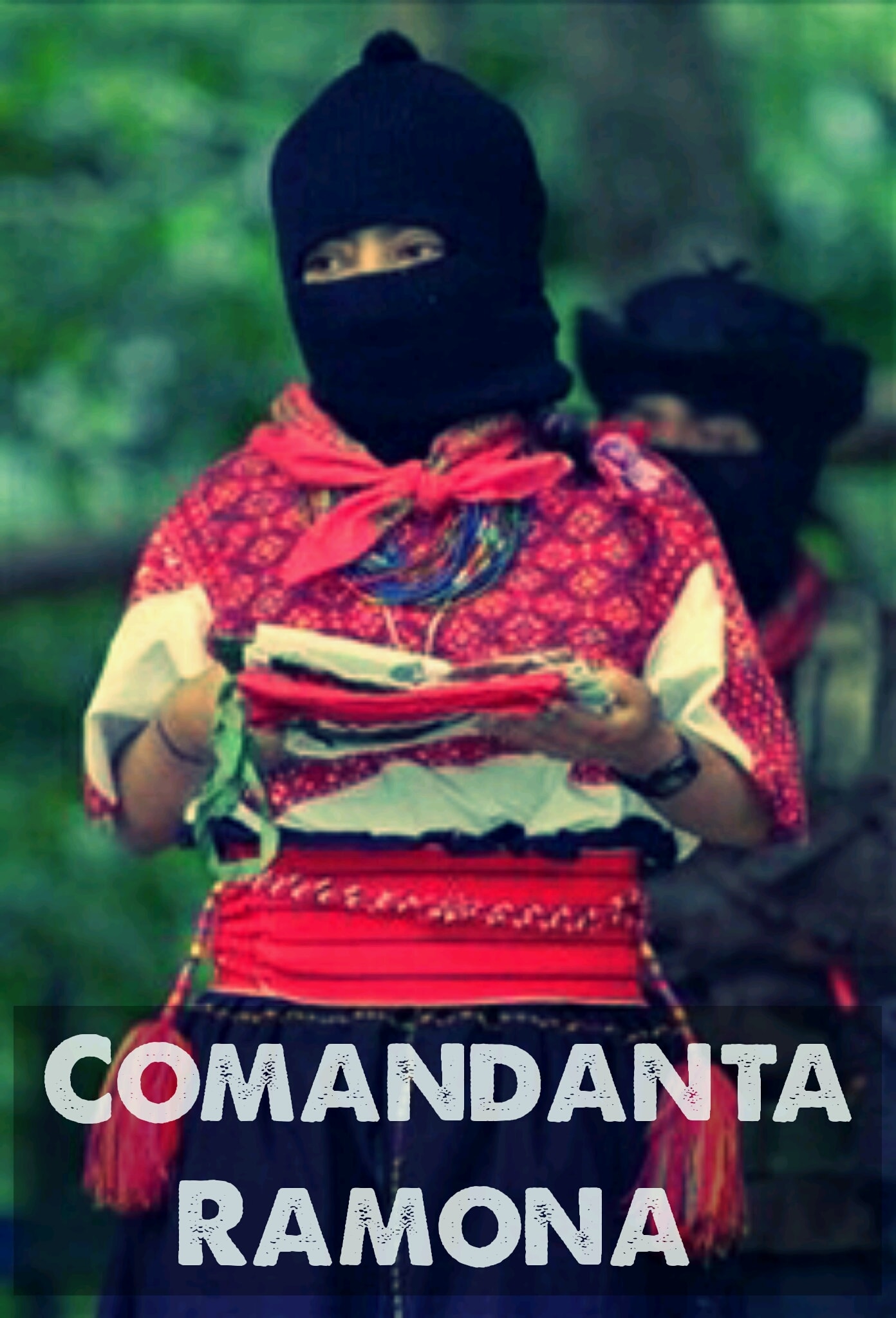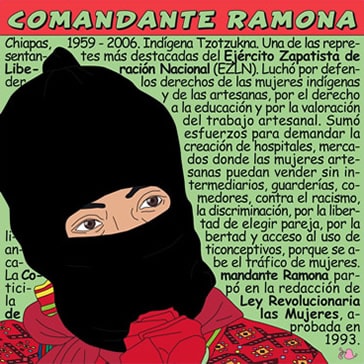 Comandanta Ramona was an influential member of the Zapatista Army or Ejército Zapatista de Liberación Nacional (EZLN) in Chiapas, Mexico. Dubbed “The Petite Warrior,” she led the Zapatistas’ initial uprising against the Mexican government, leading to to the Zapatista rebellion and the revolution of indigenous women’s rights throughout Mexico.
Comandanta Ramona was an influential member of the Zapatista Army or Ejército Zapatista de Liberación Nacional (EZLN) in Chiapas, Mexico. Dubbed “The Petite Warrior,” she led the Zapatistas’ initial uprising against the Mexican government, leading to to the Zapatista rebellion and the revolution of indigenous women’s rights throughout Mexico.
Comandanta Ramona influenced the early decisions and actions of the Zapatista Army for National Liberation (EZLN), a group of indigenous peoples in the southern state of Chiapas, Mexico who continue to struggle against government exploitation and marginalization.
Comandanta Ramona wears a black face mask and a white shirt with a red scarf. Only her eyes are visible. As a Tzotzil Mayan woman, “Ramona” left her home in search of work. She experienced the disparities between the rural communities and the larger towns. And, seeing that life was unjustly different for Indigenous women, she joined the Ejército Zapatista de Liberación Nacional (EZLN) to make life better for rural people, especially women.
As a Zapatista, her role was political. She traveled from community to community, teaching women about the Zapatista struggle.
Comandanta Ramona once told a reporter in her native Tzotzil (Spanish was her second language):
‘The women finally understood that their participation is important if this bad situation is to change. There is no other way of seeking justice, and this is the interest of the women.’
For Comandanta Ramona, activism was a two-part struggle. The first was within the Chiapas communities, where women’s roles were tied to tradition. The second was the indigenous people’s struggle against exclusion, suppression, and domination by the Mexican government.
In 1993, Comandanta Ramona drew up the “Revolutionary Law on Women.” In it, the law declared women equal to men. It was presented and voted on by women and men at an assembly and it passed. The “Revolutionary Law on Women” was made public during the Zapatista uprising in San Cristóbal de las Casas in ’94. It included 10 demands specific to the welfare of women. Comandanta Ramona couldn’t have been any more clear:
‘First: Women, regardless of their race, creed, color or political affiliation, have the right to participate in the revolutionary struggle in a way determined by their desire and capacity.
Second: Women have the right to work and receive a just salary.
Third: Women have the right to decide the number of children they will have and care for.
Fourth: Women have the right to participate in the affairs of the community and hold positions of authority if they are freely and democratically elected.
Fifth: Women and their children have the right to primary attention in matters of health and nutrition.
Sixth: Women have the right to an education.
Seventh: Women have the right to choose their partner, and are not to be forced into marriage.
Eighth: Women shall not be beaten or physically mistreated by their family members or by strangers. Rape and attempted rape will be severely punished.
Ninth: Women will be able to occupy positions of leadership in the organization and hold military ranks in the revolutionary armed forces.
Tenth: Women will have all the rights and obligations elaborated in the Revolutionary Laws and regulations.
In March of that year, two months after the uprising, the EZLN’s Indigenous Revolutionary Clandestine Committee declared 34 demands be heard and met by the Mexican government. And, it was Comandanta Ramona who coördinated the petitions of indigenous women and wrote it into the declaration. Under the twenty-ninth demand, she insisted the government improve the quality of indigenous women’s lives by doing several things. She demanded that the government build birth clinics, childcare centers, women’s artisan spaces and craft markets, and mills where women could spend the four hours it takes to grind corn to make tamales and tortillas for their families. She also wrote that indigenous women should have access to education, training, and contraceptives to help with family planning.
In 1996 Comandanta Ramona went to Mexico City to participate in the National Indigenous Forum, despite a government ban on EZLN’s participation (stemming from earlier disagreements on the San Andrés Accords). While there, she was protected by Zapatista supporters who did not want to see her arrested. The forum led to the founding of the National Indigenous Congress of Mexico.
Earlier that same year, Comandanta Ramona lobbied for the San Andrés Accords, deeming the rights of indigenous peoples in Mexico. The EZLN and the Mexican government agreed to sign the accords. Unfortunately, the government did not comply and beefed up military presence in Chiapas.
For the next several years, Comandanta Ramona continued to remain active in the push for the government’s compliance of the San Andrés Accords. She also led the EZLN women’s delegation at The First National Congress of Indigenous Women in Oaxaca in 1997. In 2001, she marched into Mexico City with other leading Zapatistas demanding that the government comply with the San Andrés Accords.
After a 10-year health struggle with cancer, Comandanta Ramona died in 2006 from kidney failure. She was en route to the hospital in San Cristóbal de las Casas—the town she seized twelve years earlier—because there was still no hospital in San Andrés de Larrainzer, where she lived. She was said to have been 47 years old.
Gata Malandra
Latest posts by Gata Malandra (see all)
- Event: World Crew Battle UK By Swatch — October 11, 2017
- Knowledge Session: Who Was Manco Inca? — May 4, 2017
- Video + Letra: Illmani ‘Saber es Poder’ — February 3, 2017

